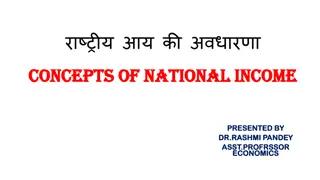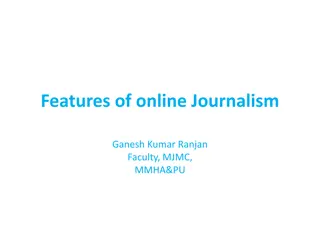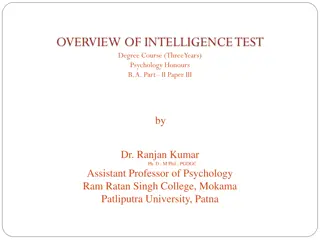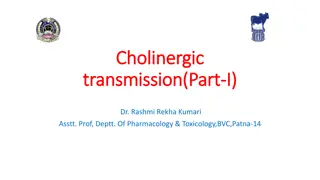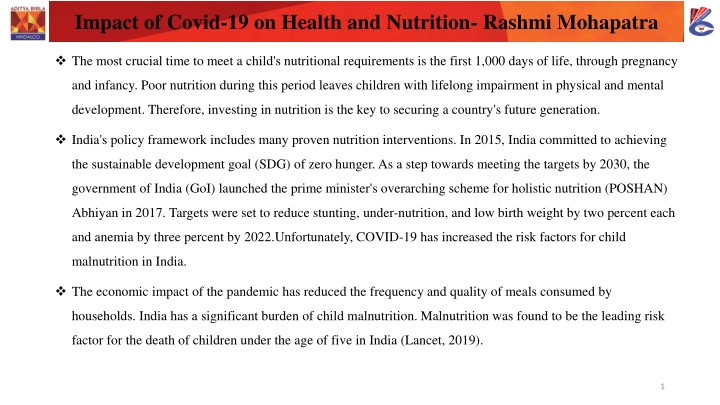
Impact of COVID-19 on Child Nutrition in India
Explore the profound effects of COVID-19 on child malnutrition in India, highlighting the concerning increase in risk factors and discussing the critical need for nutrition interventions to safeguard the future generation.
Download Presentation

Please find below an Image/Link to download the presentation.
The content on the website is provided AS IS for your information and personal use only. It may not be sold, licensed, or shared on other websites without obtaining consent from the author. If you encounter any issues during the download, it is possible that the publisher has removed the file from their server.
You are allowed to download the files provided on this website for personal or commercial use, subject to the condition that they are used lawfully. All files are the property of their respective owners.
The content on the website is provided AS IS for your information and personal use only. It may not be sold, licensed, or shared on other websites without obtaining consent from the author.
E N D
Presentation Transcript
Impact of Covid-19 on Health and Nutrition- Rashmi Mohapatra The most crucial time to meet a child's nutritional requirements is the first 1,000 days of life, through pregnancy and infancy. Poor nutrition during this period leaves children with lifelong impairment in physical and mental development. Therefore, investing in nutrition is the key to securing a country's future generation. India's policy framework includes many proven nutrition interventions. In 2015, India committed to achieving the sustainable development goal (SDG) of zero hunger. As a step towards meeting the targets by 2030, the government of India (GoI) launched the prime minister's overarching scheme for holistic nutrition (POSHAN) Abhiyan in 2017. Targets were set to reduce stunting, under-nutrition, and low birth weight by two percent each and anemia by three percent by 2022.Unfortunately, COVID-19 has increased the risk factors for child malnutrition in India. The economic impact of the pandemic has reduced the frequency and quality of meals consumed by households. India has a significant burden of child malnutrition. Malnutrition was found to be the leading risk factor for the death of children under the age of five in India (Lancet, 2019). 1
Impact of Covid-19 on Health and Nutrition Objective: To provide an overview of the nutrition, health, and health ecosystems sector before the pandemic, the changes, and impacts due to the pandemic, and briefly discusses what can be done to get nutrition, health, and health ecosystems interventions back on track, along with recommendations and policy advice on how to boost the health ecosystem's resilience. Data Methods: This study was performed by reviewing the available published literatures, case studies, and different government and non-government organizations information from reports and official websites.. 2
Introduction In India, 68 percent of deaths of children under five are due to malnutrition, or 1,935 deaths every day. The onset of the COVID-19 pandemic, subsequent lockdown, and ensuing constraints are likely to exacerbate the distress of those who are malnourished in particular, pregnant women, young mothers, and children. Estimates suggest that a decline in Gross National Income (GNI) per capita will result in a 14 percent increase in moderate/ severe wasting in children under 5 years of age, and a 22 percent increase in severe wasting. Combined with disruptions in service provision, COVID-19 could lead to several maternal and child deaths. There are two types of interventions to address fetal and child nutrition and development. Nutrition-specific interventions that address immediate determinants and nutrition-sensitive interventions that address underlying determinants Nutrition-Specific Interventions Nutrition-Sensitive Interventions Adequate food and nutrient intake, complementary feeding, caregiving, and Food security; adequate caregiving resources at the maternal, household, and parenting practices, and low burden of infectious diseases community levels; access to health services; and a safe and hygienic environment Table 1: Nutrition-Specific and Nutrition-Sensitive Interventions 3
An Overview of Indias Nutrition Sector At the Government of India (GoI) level, nutrition-specific interventions are delivered primarily through two Centrally Sponsored Schemes (CSSs): - A. The Integrated Child Development Services (ICDS) is GoI s flagship program aimed at providing basic education, health, and nutrition services for early childhood development. It comes within the Ministry of Women and Child Department (MWCD). B. The National Health Mission (NHM) aims at achieving universal access to healthcare by strengthening health systems, institutions, and capabilities, including a focus on maternal and child health. It comes within the Ministry of Health and Family Welfare (MoHFW). While these schemes have existed for a long period, progress has been slow and variable. In 2016, stunting (low height-for-age) prevalence in India was high (38.4 percent) and varied considerably across districts (range: 12.4- 65.1 percent), with stunting above 40 percent in over a third of districts. as per the National Family Health Survey (NFHS)-4 (2015-16). Updated data is available for 22 States and Union Territories from NFHS-5 (2019-20). In 13 out of 22 states for which data is available, stunting among children under five increased, and in 12 out of 23 states wasting levels increased. This is concerning. 4
Policy Focus on Nutrition The POSHAN Abhiyaan aims to holistically reduce the prevalence of malnutrition in India by 2022 using technology including the ICDS Common Application System (ICDS-CAS) a real-time monitoring system and job aid; convergence; capacity building; and behavior change communication. Simultaneously, GoI launched several other initiatives, such as the Pradhan Mantri Matru Vandana Yojana (PMMVY) a maternity benefit scheme aimed at compensating women for wage loss and promoting health and nutrition-seeking behavior; the Anemia Mukt Bharat (AMB) for addressing the high prevalence of anemia; and a Jan Andolan (people s campaign) for Social and Behaviour Change Communication (SBCC). The launch of these schemes has led to a re- prioritization of nutrition outcomes, with clear targets being laid out to be achieved by 2022. Indicator Targets (by 2022) Prevent and reduce stunting in children (0- 6 years) From 38.4% [as per the fourth round of the National Family Health Survey (NFHS-4)] to 25% Prevent and reduce under-nutrition (underweight prevalence) in By 6 percentage points at a reduction rate of 2% per annum children (0-6 years) Reduce the prevalence of Anemia among young children (6-59 By 9 percentage points at a reduction rate of 3% per annum months) Reduce the prevalence of Anemia among women and adolescent By 9 percentage points at a reduction rate of 3% per annum girls (15-49 years) Reduce Low Birth Weight (LBW) By 6 percentage points at a reduction rate of 2% Table 2 : POSHAN Abhiyaan Targets 5
Challenges Before the pandemic, the delivery of nutrition-specific interventions was impeded by several challenges. Broadly, they can be classified into three types: Access and equity issues Bottlenecks in specific interventions, such as the delivery of food supplements Lack of an enabling environment for delivery. Coverage: On average, nationally, no major nutrition-specific intervention exceeded 70 percent even coverage in 2015-16. Coverage of interventions ranged from 65 percent for Iron and Folic Acid (IFA) during pregnancy and nutrition to just about 50 percent or less for most other interventions such as food supplements and Ante Natal Care (ANC). Consequently, most households did not receive all the nutrition interventions. For instance, Menon et al (2019) found that only two of 1,417 households (0.1 percent) received all 19 nutrition-specific and nutrition- sensitive interventions spanning various departments. In addition to low coverage across interventions, there are also significant inter-state and inter-district variations in coverage. For instance, the coverage of food supplements ranged from barely 3 percent in some districts to over 95 percent in others. 6
Challenges (1) Inequitable access and exclusion (2) Declining beneficiaries at AWCs (3) Reduction in dietary quality (4) Awareness, enrolment and payments part of maternity benefit cash transfers (5) Vacancies and overburdened functionaries (6) Finances Figure 1: Coverage of Core ICDS Interventions in 2015-16 Source: International Food Policy Research Institute. Data Note No. 4. July 2018. Online: http://ebrary.ifpri.org/utils/getfile/collection/p15738coll2/id/132803/filename/133015.pdf. 7
The Effects of the Pandemic on Nutrition and Health Services (1) Income decline (2) Nutrition and Health System Disruptions (3) Governance issues due to the COVID-19 pandemic Healthcare systems were stretched to breaking point by the pandemic and had to rely almost exclusively on their most important resource: people. It became obvious that what has been advocated by the health community for years is urgently needed: we need to find ways to recruit and retain a highly trained and motivated workforce. We need to look at the role of different health workers, of patients, and their careers, and of increasingly sophisticated technology, and decide what is the best way to provide care that is responsive to the needs and expectations of patients. We need to expand our horizons and look ahead. We need to bring physicians, vets, and ecologists together. Much progress has been made in fostering collaboration between the UN agencies involved, the world health organization (WHO), the food and agriculture organization (FAO), the world animal health organization (WAHO), and the UN environment program (UNEP). But much more needs to be done at the national and local level and, above all, in the way we think about these challenges and the solutions we propose to the common challenges. The power of scientific innovation to promote and protect health. we need to look systematically at where further advances are needed, based on the simple criteria of whether they offer the potential to improve one health and how we can create a true (3P Model) partnership between the public and private sectors in which the risks and the returns are shared. None of this will be possible with changes to the global governance of health. These include a new pandemic treaty, a global health board, modelled on the financial stability board created by the G20 after the global financial crisis. 8
Policy Measures Needed For Nutrition and Health System Disruptions Sufficient allocations should be made to ensure a stock of iron, calcium, and Vitamin A supplements, and essential medicines for children at Primary Health Centres, for distribution by frontline workers. Gaps in the supply chains of IFA tablets under AMB should be addressed. Tracking of acute malnutrition during the pandemic should be accelerated through regular, mobile-based communication by frontline health workers (ASHAs and ANMs). Budgetary support for facilitation and training for these activities should be provided. The government must invest in PPE and appropriate incentives for frontline workers including ASHAs and ANMs. States must invest in decentralized procurement and decision-making so that zones with different levels of COVID-19 transmission can choose between mechanisms for service delivery (doorstep delivery or community level). Allocations for important schemes addressing child and adolescent health such as Rashtriya Kishor Swasthya Karyakram (RKSK) and Scheme for Adolescent Girls (SAG) must be increased in the coming years. Critical shortages of health professionals in rural and urban health facilities must be addressed and adequate investments made to upgrade the physical infrastructure at existing facilities. For this, there must be adequate provisioning under NHM and the Health and Wellness Centre component of Ayushman Bharat. 9
Policy Measures Needed For Nutrition and Health System Disruptions Food security is a big challenge during the pandemic. A survey of 12 states found that many households were reducing the number of food items in a meal and the number of meals in a day. This is supported by reports that rural India was already eating less food and less nutritious food. Government should continue the distribution of free grains under PMGKY. Effective measures are needed to solve issues that hamper the public distribution system (PDS). In a situation of the hunger crisis, biometric identification and legal documentation should be eased. Ration should be provided to all regardless of whether they have linked their ration card to an Aadhar card, and a system should be in place to update the ration cards to include the names of children born after 2011. It is critical to strengthen the coverage of the food-based social security nets to include many vulnerable people who are currently out of the food system across different States. The PDS should be universalized and expanded to include all vulnerable groups. This measure is necessary to address malnutrition among children belonging to such vulnerable households. Universal PDS models have proved to be an effective way to reduce exclusion errors and leakages. The Government of India (GoI) should provide an adequate budget to strengthen the system of FCI. There is a need to maintain transparency and improve accountability in the distribution system. Inspections and grievance redressal constituted with the PDS, or local government should be strengthened to ensure the smooth functioning of the food distribution system and minimize power asymmetries. Food-based social security nets i.e., PDS, ICDS, and MDM (Mid Day Meal)should be strengthened by adding food grains with higher nutritive value like ragi, bajra, jowar etc. 10
What can be done? There are several immediate steps that must be taken to arrest the decline in coverage and service provision due to the COVID-19 pandemic. India has 22.17 crore children under 5 years of age, and 3.96 crore pregnant women and lactating mothers, all of whom are at-risk, and therefore, providing services requires great care. The decline in service provision, combined with a fall in incomes, and an increase in medical wasting conditions can lead to increased mortality. Nutrition services should be delivered while taking precautions (protective equipment, social distancing, etc.) to prevent the spread of COVID-19. Also, while most services have resumed across states after the lifting of the lockdown, restarting all services is necessary, and states would need to be able to have options on how to deliver these services. Furthermore, states must determine ways to register new beneficiaries, given that AWCs are shut. Even in the absence of opening AWCs, some recommendations are given below (Table 3) Intervention Recommendation A lot of services being provided are COVID-19 specific, and these services are being Food supplements Maintaining food security delivered at home. These include counselling on social distancing, or the home delivery of rations. These activities can be combined with nutrition interventions such Micronutrients Restart travel routes and supply chains as counselling and ANC check-ups, the provision of IFA and other drugs, and the Counselling distribution of food supplements. Expand use of digital platforms where possible Continue cash transfers as they have found some success. However, the amounts given should be revisited to ease loss of household income Maternity benefits Immunisation Continue routine immunisation while taking all precautions. Delayed or missed immunisations should be administered based on WHO guidelines Breastfeeding Continue, even if the mother has COVID-19 Table 3: Recommendations to Improve the Provision of Nutrition-Specific Interventions 11
What can be done? To strengthen access and coverage. The focus on building an enabling environment of fiscal and human resources will be critical. This includes ensuring FLWs have adequate safety equipment and providing additional incentive payments or increasing honoraria and salaries. Expanding coverage is essential given pre-existing vulnerabilities being exacerbated by COVID-19. This would require budgeting for 100 percent of the target population. India should have spent at least 58,707 crores in FY 2019-20, across Union government Ministries and State government Departments to fully finance a set of nutrition-specific interventions. Allocations for nutrition-related schemes including the additional funds by the 15th Finance Commission for ICDS should be ring-fenced to ensure all services are adequately provided. Finally, Initial state-wise trends from 2019-20 show that even as coverage for some interventions like IFA provision improved, outcomes such as anemia stagnated or worsened. This highlights the importance of looking at underlying causes such as loss of income and economic decline. In conclusion, with approximately 75,000 children born every day, it is critical that the nutritional needs of children and women are protected to ensure that gains made prior to the pandemic are sustained and improved upon. 12
References Ministry of Health and Family Welfare (MoHFW), Government of India, UNICEF and Population Council (2019): "Comprehensive National Nutrition Survey (CNNS) National Report", New Delhi. https://nhm.gov.in/WriteReadData/l892s/1405796031571201348.pdf Institute for Health Metrics and Evaluation (IHME). https://vizhub.healthdata.org/gbd-compare/. Maternal and Child Nutrition Study Group. 2013. Executive Summary of the Lancet Maternal and Child Nutrition Series. https://www.thelancet.com/pb/assets/raw/Lancet/stories/series/nutritioneng.pdf. 2020 Global Nutrition Report: Action on equity to end malnutrition. Bristol, UK: Development Initiatives. https://globalnutritionreport.org/reports/2020-global-nutrition-report/. Ministry of Health and Family Welfare. My Safe Motherhood: booklet for Expecting Mothers. Ministry of Health and Family Welfare, Government of India. Available onlhttps://nhm.gov.in/ images/pdf/programmes/maternalhealth/guidelines/my_safe_motherhood_booklet_english.pdf. World Health Organisation. February 2019. Multiple micronutrient powders for point-of-use fortification of foods consumed by children 6 23 months of age. e-Library of Evidence for Nutrition Actions (eLENA), WHO. Ministry of Health and Family Welfare. My Safe Motherhood: booklet for Expecting Mothers. Ministry of Health and Family Welfare, Government of India. 13


